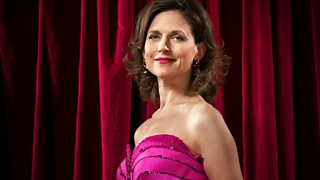
Beethoven - Symphony No. 3 in E flat major (Eroica)
The �鶹Լ�� SSO perform Beethoven's Symphony No. 3 (Eroica).
Katie Derham continues Radio 3's month of programmes complementing the �鶹Լ��4 series "Symphony" with Beethoven's mighty 'Eroica' - originally dedicated to Napoleon Bonaparte and by far the biggest Symphony ever composed at the time of its first performance in 1805.
Beethoven: Symphony No. 3 in E flat major (Eroica)
�鶹Լ�� Scottish Symphony Orchestra
Donald Runnicles (conductor).
LUDWIG VAN BEETHOVEN (1770–1827)
Symphony No. 3 in E flat major, Op. 55, ‘Eroica’ (1803)
1 Allegro con brio
2 Marcia funebre: Adagio assai
3 Scherzo: Allegro vivace
4 Allegro molto
“A major milestone in the history of music, 'Heaven and Earth must tremble beneath it' when the Eroica is performed.”
Beethoven began composing his Third Symphony against a background of growing deafness and inner turmoil, which came to a head in his famous Heiligenstadt Testament of October 1802. Here he revealed the depths of his despair, indicating that he had considered ending his life: ‘Only my art held me back.’ Having rejected suicide, however, he threw himself into his art with renewed determination, and about that time conceived the idea of a grand new symphony in E flat. He had already composed two symphonies, but the new one was to outstrip anything he had previously written.
For a starting point he took the finale theme from his recently performed and popular ballet The Creatures of Prometheus. He had already turned this theme into a ballroom dance, and also just completed a set of piano variations based on it. Now it was to become the main theme of the finale of his new symphony. The ballet portrays Prometheus as the heroic creator of humanity, who subsequently civilises his creations through the arts, and Beethoven clearly hoped his new symphony would similarly elevate mankind spiritually.
The main sketching of the symphony took place in summer 1803, after a successful concert in April that included the premieres of his Second Symphony and Third Piano Concerto. Beethoven played the new symphony on the piano to his friend Ferdinand Ries as soon as it was completed, and Ries was overwhelmed by its magnificence. ‘I believe that Heaven and Earth must tremble beneath it when it is performed,’ he wrote, adding that Beethoven regarded it as the greatest work he had yet composed.
Beethoven’s initial plan was to dedicate the work to Napoleon Bonaparte. He evidently perceived him as a suitably powerful figure and champion of liberty – perhaps even as a latter-day Prometheus. Since Beethoven’s patron Prince Lobkowitz wanted the dedication, however, Beethoven allowed this and decided instead to use ‘Bonaparte’ as the title of the symphony. But on hearing that Napoleon had proclaimed himself emperor and was clearly set on becoming just another tyrant, Beethoven changed his mind, angrily tearing up the title-page of the symphony.
At the first trial runs of the symphony in Prince Lobkowitz’s palace in 1804, and again at the first public performance in 1805, Beethoven’s supporters were wildly enthusiastic, as Ries had been, but many other listeners were completely bewildered by the extremely long, complex and seemingly bizarre construction of the work, which transcended the boundaries of the traditional symphony in so many ways. In the face of such criticism, Beethoven refused to change a single note; but when the symphony was finally published in 1806 he provided some helpful guidance, suggesting that, in view of its length, it was best played early in a concert, before the audience was too tired (concerts at that time were generally much longer than modern ones). As an additional help with understanding the work, Beethoven at this stage (and not earlier) gave it a programmatic title: Sinfonia eroica … composta per festeggiare il sovvenire di un grand Uomo (‘Heroic Symphony … composed to celebrate the memory of a great man’), or more briefly, the ‘Eroica’. The identity of the ‘great man’ was left deliberately unspecific: it could be any hero, including an idealised Napoleon or even the composer himself.
The first movement is in traditional sonata form, but on a much larger scale than ever before. Because it was so long, Beethoven considered omitting the customary repeat of the exposition, but eventually concluded the work sounded better with it. The central development section is huge, and builds up to a mighty climax with ferocious discords before dropping back to piano, at which point a new, lamenting theme unexpectedly appears in the remote key of E minor. The recapitulation is heralded by a horn entry that seems to be too early, creating peculiar discords with the strings before the full orchestra finally enters fortissimo with the opening theme again. The coda is also exceptionally long, and brings back the new theme from the development section before ending in a blaze of glory.
The second movement is a funeral march. It may seem strange that the ‘great man’ of the symphony should be dead by the second movement, but the remaining two movements can then represent his apotheosis, as he takes his place in immortality among the gods. This second movement is essentially in ternary form: minor – major – minor; but there are various interpolations and extensions, and again a long coda, stretching the movement well beyond its basic structure.
The size of the orchestra is hardly any larger than for Beethoven’s Second Symphony, but there is one important addition: a third horn. The three horns give a sense of particular boldness, and they are especially prominent in the central Trio section of the third-movement Scherzo.
The finale is the most complex movement of all, being a combination of various musical arts – dance, variation, thematic development, march, fugue – just as Prometheus had introduced mankind to the various arts in Beethoven’s ballet. Creating a satisfactory finale for a symphony can be a major problem, for it needs to be light and tuneful and yet to make a grand climax for the whole work; Beethoven’s solution on this occasion was to use the simple ballet tune combined with a sophisticated structure that can be viewed in many ways. After a brief, stormy opening, the first part of the movement is built in the same way as that of his piano variations on the same theme: instead of hearing the theme first, one hears a bare, statuesque bass line (perhaps recalling Prometheus’s statues that he brought to life as human beings). This bass line is then decorated with increasingly elaborate counterpoint until the main theme appears. Thereafter, however, the pattern is less clear, with a couple of fugal sections, a march in G minor, and a long slow section containing two more variations on the main theme. The work concludes with an exhilarating coda. No wonder Ferdinand Ries was so impressed at that first hearing – the ‘Eroica’ forms a major milestone in the history of music.
Programme note © Barry Cooper
Duration:
Credits
| Role | Contributor |
|---|---|
| Composer | Ludwig van Beethoven |
| Orchestra | �鶹Լ�� Scottish Symphony Orchestra |
| Performer | Donald Runnicles |
This clip is from
Featured in...
![]()
More... Symphony
More highlights from the 'Symphony' season on Radio 3 and �鶹Լ�� Four.
More clips from Afternoon Concert
-
![]()
Charles Ives: The Unanswered Question
Duration: 06:28
-
![]()
Mahler: Adagio, from Symphony No 10 (arr. Castelletti) (excpt)
Duration: 01:43






